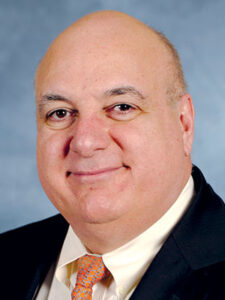Emerging trial data are changing approaches to kidney disease, diabetes, and cardiovascular disease. ADAMeetingNews.org spoke with three presenters who will review the latest data during Friday’s symposium Diabetic Kidney Disease and Cardiovascular Disease in Diabetes, which will begin at 2:00 p.m. in N-Hall E (North, Exhibition Level).
Why the intense focus on kidney disease, cardiovascular disease, and diabetes in 2019?

George Bakris, MD, Professor of Medicine and Director of the American Heart Association Comprehensive Hypertension Center, The University of Chicago: If you intervene early enough, you can reduce the absolute risk in any given patient by 20 percent for developing not only diabetic kidney disease but also cardiovascular death. We have had ACE inhibitors and ARBs since the early 2000s; but since then nothing new until the SGLT inhibitors and GLP-1 agonists. The validated biomarkers of not only kidney disease progression but also cardiovascular risk have inflammation as a common factor. We have clear trial data showing that you can treat all three simultaneously — renal disease, cardiovascular disease, and diabetes.
What are the cardiovascular benefits of these new agents?
Amanda Vest, MBBS, MPH, Medical Director of the Cardiac Transplantation Program and Assistant Professor of Medicine at Tufts University School of Medicine: The SGLT2 inhibitor and GLP-1 agonist drug classes, developed to control glucose levels for patients with type 2 diabetes, have now been shown to reduce the rate of cardiovascular death, with SGLT2 inhibitors additionally preventing hospitalizations for heart failure. In so many patients with diabetes and heart failure, there’s also chronic kidney disease. With heart failure, in particular, there’s a bidirectional relationship: Diabetes significantly increases the risk of developing heart failure and heart failure fuels diabetes development.
What are the renal benefits?
Sankar D. Navaneethan, MD, MS, MPH, Associate Professor of Nephrology at Baylor College of Medicine: ACE inhibitors and ARBS slow kidney disease progression and lower cardiovascular disease. SGLT2 inhibitors, and possibly DPP-4 inhibitors, have additional renal benefits, both GFR (glomerular filtration rate) decline and reduction and proteinuria.
Can these newer agents prevent cardiovascular and renal disease as well as slow progression?

Dr. Vest: Cardiologists are increasingly thinking about type 2 diabetes as a component of cardiovascular disease management. The concept of prescribing diabetes medications to help cardiovascular outcomes hasn’t quite permeated through the field, yet. At Tufts Medical Center, we created a pocket card to guide our endocrinology, cardiology, and primary care colleagues with patients who have type 2 diabetes and cardiovascular disease or cardiovascular risk factors.
Dr. Navaneethan: Recent clinical trials have demonstrated the beneficial effects of SGLT2 inhibitors in mild to moderate kidney disease, including those with proteinuria. The CREDENCE trial extends that benefit to GFR as low as 30, but data in those with stage 4 and 5 chronic kidney disease are lacking. We also know that 65 percent of patients with chronic kidney disease are on ACE/ARBs. SGLT2 inhibition might offer additional cardiovascular and renal benefits. With the newer therapies being introduced, we can expect a similar challenge in uptake due to adverse events, which should be studied further.
Dr. Bakris: Controlling blood pressure, lipids, and glucose mitigates against high levels of inflammatory biomarkers being present if you do it early enough to prevent damage. SGLT2 inhibitors do much more than that. In fact, SGLT2 inhibitors may be thought of as cardiorenal risk-reducing agents that have glucose lowering as a side effect since they are effective to glomerular filtration rates of 25 ml/min to 30 ml/min where no glucose reduction would be predicted.